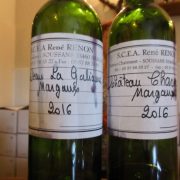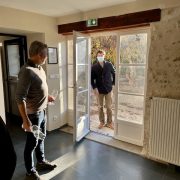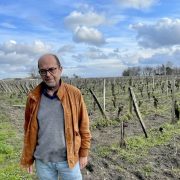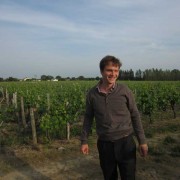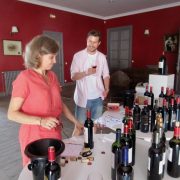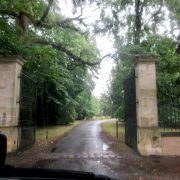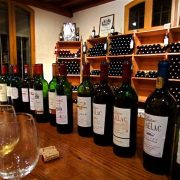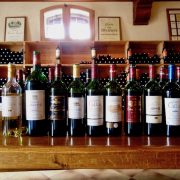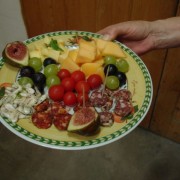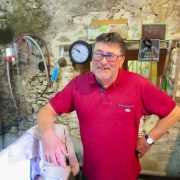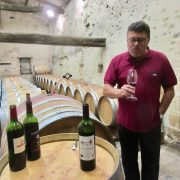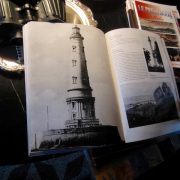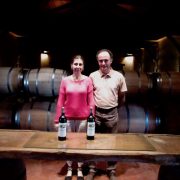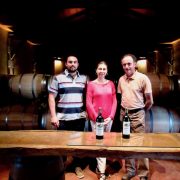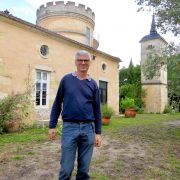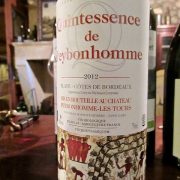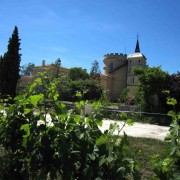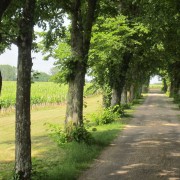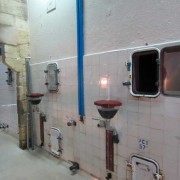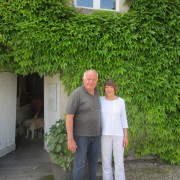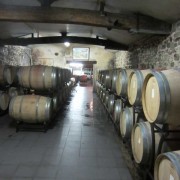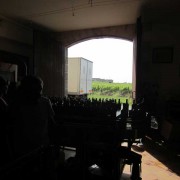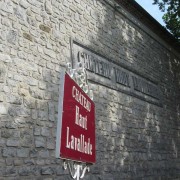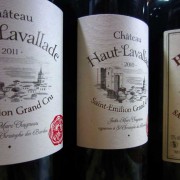What is Bordeaux?
Bordeaux is a city, a region and a wine. Strictly speaking, several wines; red, white, sweet white, rose and sparkling. Whilst they produce some great dry white wines and some of the most highly-valued sweet wines, it is their red wines that have set the benchmark for centuries.
What is known today as a Bordeaux blend is usually Cabernet Sauvignon with Merlot. Cabernet Franc often finds its way into the blend (very occasionally in high proportions as at Cheval Blanc, Ausone and some vintages of Vieux Chateau Certan), as do Petit Verdot and Malbec (which was the dominant grape variety 200-300 years ago). The proportions vary depending on where you are in the region.
You will hear the terms Left Bank and Right Bank. Bordeaux, the city, sits on the Left Bank, the south bank of the river Garonne. Graves is at the south and southeast end of the city with Pessac-Leognan overlapping the suburbs. The Medoc continues northwest of the city, along the Left Bank, along the Gironde estuary almost as far as the Atlantic, through communes including Margaux, St-Julien, Pauillac, St-Estephe.
The Right Bank refers to the the north shore of the Dordogne, from Castillon at the east end (at the western edge of Bergerac), west through St-Emilion, Pomerol, Libourne, Fronsac and beyond. Beyond where the Dordogne flows into the Gironde estuary, along the north bank through the Cotes de Bourg and as far as the mediaeval fortress town of Blaye.
There is a triangle of land between the two converging rivers called Entre-Deux-Mers, a fertile zone where much affordable white wine is produced (usually Sauvignon Blanc with Semillon and Muscadelle) and straight red Bordeaux and Bordeaux Superieur.
As a generalisation, the Left Bank has more Cabernet Sauvignon and less Merlot in its blend and the Right Bank more Merlot and less Cabernet Sauvignon. After decades of enologists and journalists’ influence, it is increasingly hard to find Cabernet-heavy blends on the Left Bank.
A Short History
Bordeaux has been an important trading post since Roman Times.
In 1152 Henry II (Henry Plantagenet) married Eleonor of Aquitaine and, for the next 300 years, Bordeaux was controlled by England. Above all Bordeaux was a trading port, handling wine from Gascony – Gaillac was the most sought-after. As time passed, Graves rose in popularity.
Bordeaux became prosperous and, partly as a result of tax exemptions, England was its major market. The English fleet of merchants would arrive in October, sample the new wines and return to England with their cargo before Christmas. The wine was Clairette (which is where the name Claret comes from), thought to be more rose in colour than red.
The wealthy Bordelais considered themselves Gascon rather than French and were happy to be separate from France. Successive French Kings had their eyes on Bordeaux and the English were finally booted out following the Battle of Castillon in 1453. Wisely, the French did not want to kill the fatted calf, so trade recommenced soon afterwards.
Dutch merchants with their large fleets came to the fore in the 1500s. They were also able to bring other expertise and started draining the marshes of the Medoc.
Their trade was strangely compatible with the English – the Dutch wanted high volume with low prices and lower quality whereas the English were more interested in higher quality and were less price-conscious.
Demand was building in the Netherlands, in Hamburg and Scandinavia (although England remained the largest importer) and, as a result, vines were being widely planted in the newly-drained Medoc.
The first mention of a specific vineyard or named Chateau was in 1663. Samuel wrote in his diary on 10th April “…to the Royal Oak Taverne…and here drank a sort of French wine called Ho Bryan tha hath a good and most perticular taste that I never met with.” He frequently refers to Claret or Clarets in his diary, so there must have been alternatives.
Ho Bryan (which became Haut Brion) was also known as Pontac, named after the owner, who also had a tavern in London where his top wine was already more expensive than others. Claret was also sometimes referred to as Pontac at this time.
The Merchant System
The merchant system developed in the 1600s is still broadly intact today. It is an odd structure with an additional layer between the Chateaux (or their Proprietors) and the Negociants (the Merchants) called Courtiers. The Merchants were not massively keen to travel out of the city of Bordeaux up into the muddy Medoc, so a band of Courtiers emerged, Go-Betweens with good ground knowledge of the estates that spawned after the draining of the marshes. They are still part of the system today – invisible to everyone apart from the Estates and the Merchants. We at The Winery work with a couple of Merchants in the region who own a handful of their own Chateaux and each run a Negociant business dealing with wines of other collectable estates. Even they can’t approach the top estates directly and that part of the business is still negotiated through Courtiers.
1855 Classification
A hierarchy of Chateaux and their relative prices was already in place before 1855 and this was just one of many compiled by merchants and brokers. Requested by the Bordeaux Chamber of Commerce for the Paris Exposition, it was a classification of Left Bank Chateaux organised into First-Fifth Growths. There were only two subsequent changes: Cantemerle was instated as a 5th Growth in 1856 and Mouton, after decades of lobbying by Philippe de Rothschild, was reclassified as a First Growth in 1973 by Decree of President Chirac.
The classification was never meant to be definitive but, despite much animated discussion over potential reclassification, it has stuck. While we might nitpick over the relative quality of certain estates from Second – Fifth Growth, there can be little argument over the long term status of the First Growths.
A bottle of mature Latour, Lafite, Margaux, Haut-Brion or Mouton is definitely a thing of beauty.
Chateau Charmant & La Galiane (Margaux)
Madame Christiane Renon has two Chateaux in Margaux – La Galiane and Charmant. We love the soft, easy style of her Chateau Charmant year in, year out.
Chateau Bonnange (Blaye)
Wow. Such flesh and suppleness. This is classy Bordeaux, made with enormous care and attention to detail. Great to taste before you see the prices. If you had told us this was a £50+ Pomerol, we would not have been surprised. Should be less than half that on our shelves soon.
It was the result of an unexpected meeting crammed into a busy morning. We had a rendezvous with Pascal Montaut of Chateau Les Jonqueyres at the tail end of 2021. “I have some news” he said. “I retired and have sold the Chateau. Come with me, I’ll introduce you to the new owners.”
Chateau Calon (Montagne-Saint-Emilion)
Bordeaux. Old School, mature vintages.
Jean-Noel Boidron can trace his family’s roots in wine back to 1760. From our perspective, he has two key Chateaux. Corbin-Michotte in Saint-Emilion, bought in 1959, is close to Cheval Blanc and Figeac, where Saint-Emilion meets Pomerol. Chateau Calon straddles two of Saint-Emilion’s satellite appellations: Saint-Georges-Saint-Emilion and Montagne-Saint-Emilion.
Jean-Noel, a gentleman of a certain age, was Professor in Oenology and Wine Chemistry (with a particular specialism in Aroma) at Bordeaux. He is obsessed with aroma. Although he is a big one for controlling temperatures, his cellar looks like a time capsule. Unlike most of the shiny cellars in Bordeaux, there is no new equipment to be seen. He uses cement tanks (and why not?) and old barrels two levels underground, like the Bat Cave, where it is very fresh. All very traditional and Old School.
Corbin-Michotte can be tough young – just the way we like it. Built for long ageing. Classified in the Saint-Emilion rankings since its inception in 1955, Corbin-Michotte lost its place in the 2012 ranking but was reinstated in 2022. The wine had not changed since the beginning, but remained resolutely traditional. This may have reflected the shift in Bordeaux to consultant-led wines and, shall we say, shiny, chic, less traditional styles.
We are particularly fond of the Calon from the Saint-Georges-Saint-Emilion appellation. Certainly packed with aroma, a bit lusher than the Montagne wines, but very much built to last. We are big fans of the 2006 and 2010 at the moment.
We were sorry to hear from Emmanuel, one of Jean-Noel’s sons, that his father died in September 2023. Corbin-Michotte and Calon are in steady hands: Emmanuel has run the chateaux with his wine-making brother Hubert for decades.
Horeau-Beylot (Libourne)
Our neighbour from the Art world Charles Asprey put us in touch with friends of the family the de Lavaux in Libourne. They co-own several Chateaux on the Right Bank including Martinet (St Emilion), Clos des Galavesses (Lalande de Pomerol), St Pierre, Renaissance (Pomerol). Sounds very grand, what with offices on the Quai in Libourne. What we found was a very down-to-earth family with wines which were a welcome relief after days of tasting St Emilions that were so oaky it was like licking timber. Gentle, classic, round. A lunch at daughter Inez and her husband Stanislas’ saw us walk out with a massive jar of Lamprey a la Bordelaise. River Lamprey is certainly one of the ugliest creatures on the planet, like some razor-teethed monster from Alien, the stuff of nightmares. In fact, the Romans would often feed their least popular prisoners to pools filled with Lamprey. Nice. They may look horrific, but they certainly have the sweetest flesh of any eel, particularly cooked in red Bordeaux with Leeks. Who says you shouldn’t have red wine with fish?
There have been some new developments over the past half decade. Inez and her brother Axel have taken over from their father and more recently the dashing Axel has installed himself at, and concentrated on, Chateau Martinet.
Philippe & Jean-Pierre Riviere (Saint-Emilion)
Philippe Riviere, with his brother Jean-Pierre, co-owns the Clos des Menuts, one of our favourite Saint-Emilions. They also individually own chateaux in Saint-Emilion’s satellite appellations. Jean-Pierre has Chateau Picampeau (aka Chateau Haut-Piquat) and Philippe owns Chateau de Lavagnac, a 15th century fort, down the hill from the picturesque town of Saint-Emilion, so close to the Saint Emilion line that it’s still north of the Dordogne but just inside the Bordeaux Superieur zone.
Lavagnac is a classic Right Bank Bordeaux blend of 75% Merlot, 20% Cabernet Sauvignon and 5% Cabernet Franc, punching well above its modest, basic Bordeaux status.
As is common in Bordeaux, Philippe, with the help of his son Nicolas, also runs a negociant business. They offer a spread of Chateaux, many exclusive, including the fabulous, grassy Sauvignon Blanc led Chateau Larmevaille Entre-Deux-Mers. We also regularly trawl their stock of Chateau de Callac Graves in older vintages.
Chateau La Corne (Le Pian-sur-Garonne) LOW INTERVENTION
“I am an old Winery staffer (’84-’86) who is now making his own natural wine here in Bordeaux.” That got our attention.
Steve Lawrence, originally from Buckinghamshire, came to see us in Spring 2022. He had worked at The Winery from 1984 and 1986 before heading to the States for a career in selling wine. There he met Diana Lucz, originally from Tucson Arizona, who was also working in wine. A long term ambition emerged, to have their own winery. Napa, where they were living, was out of reach, as was California generally. They did however find a small estate in Bordeaux on high ground just across the river Garonne from Langon, not far from Sauternes and Barsac. It’s very small, but 2.5 hectares of old vines planted in 1945, 1955 and 1981 is enough for them to farm and vinify themselves, with extreme care. They make around 3,000 bottles a year from their 9,000 vines.
The blend for the white varies depending on the conditions. 2019 was 55% Semillon/45% Sauvignon Blanc, so has a wonderful, oily, nutty, honeysuckle nose. The 2020 was 75% Sauvignon Blanc/25% Semillon and is classically grassy Sauvignon. There is usually a splash of Muscadelle.
The red is usually 40% Cabernet/40% Merlot/10% Cab Franc/10% Malbec & Carmenère. Savoury and dry, coffee bean and violets in 2019 and fruit-foreward in 2020.
Their top red is called Cote Sud, their best barrel of Cabernet Sauvignon – deep, dense, supple and impressive.
Chateau La Haye (Saint-Estephe)
Chris Cardon is the owner of the owner of a veterinary pharmaceutical company with headquarters in the outskirts of Bruges, Belgium. He took part in the Medoc Marathon a few years ago – an unusual, messy form of marathon that involves wine at every waypoint. Chris fell in love with the region and decided he wanted to buy an estate. In 2012 he became the owner of Chateau La Haye in Saint-Estephe.
The Chateau, one of the oldest in Saint-Estephe, was originally a hunting lodge used by Henry II and Diane of Poitiers. Henry was married to Catherine de Medici, but always retained a “special affection” for Diane, who had been his governess. An affection so special that their H and D interlaced monogram was carved in stone at the Chateau’s entrance and has carried through to the labels today.
Janot Bernard of Leyssac bought the property and planted the first vines in 1557. The property stayed in the Bernard family until the 1920s.
We first fell in love with La Haye with their 2010 and, with the help of Andre Bertrem who works for Chris, bought as much as we could. The 2010 is long gone but we have just scooped up the last of their moreish, mineral 2012s.
Chateau Les Jonqueyres (Blaye) BIODYNAMIC
Pascal Montaut is held to be the champion of Blaye, on the opposite bank of the Gironde to Pauillac. Joined by his ex-Paris Media wife Isabel, there is something slightly battle weary about him. He is passionate and his wine is excellent. Supple, balanced, judging the fine line between traditional and modern. One of the best we tasted on the whole trip. At one point Isabel brought a plate of snacks, including the snowy white shrimps that can only be found in the estuary here once a year. Who says you shouldn’t have red wine with seafood?
Chateau Laujac & Tour Cordouan (Medoc)
It was our local Art-dealer friend Charles Asprey who pointed Vanessa Dubosq (born Cruse) of Chateau Laujac towards us.
You forget how big the Left Bank is until you head for Begadan to visit Laujac – it’s way beyond Pauillac and Saint-Estephe, and 75kms from the centre of Bordeaux.
When you finally arrive, you find that Laujac is a fascinating group of buildings – a chateau & farmstead with homes originally built for workers and sprawling land holdings with 61 hectares of vines, 400 hectares of forest and pastures for livestock. The chateau was built in 1810 in the classical style commissioned by M de Villemot, who had made his fortune furnishing guns and supplies to Napoleon.
The Cruse family were wine merchants from Denmark. In 1852 Vanessa’s Great-Grandfather Hermann Cruse was keen to buy a chateau and it came down to a choice between Laujac in the northern Medoc and Cos d’Estournel in Saint-Estephe. At the time, Laujac was held to be similar in quality to some Pauillac estates. Nowadays the hierarchy may be different!
Vanessa trained as an architect and met her husband Rene Dubosq in New York, while he was working for IBM. She started selling Laujac in the States before they both moved back to France to run the estate.
Laujac is a blend of 65% Cabernet Sauvignon, 30% Merlot and 5% Petit Verdot grown on gravelly soil with a hint of clay. Tour Corduoan, named after the island lighthouse close to the entrance of the Gironde estuary, is Laujac’s junior bottling, a 50/50 blend of Cabernet Sauvignon and Merlot from young vines and raised in oak for 6 months. Both wines are silky and very stylish.
Domaine de Grandmaison (Pessac-Leognan)
One of the high points of our recent week in Bordeaux was finding Domaine de Grandmaison. Our first night was in Blaye, a fortified town on the Gironde estuary with a citadel and a hotel/restaurant called La Citadelle. Their wine list was unpromising. None of their local Blaye wines were tempting, however, somewhat bizarrely, they did have a clutch of wines from Péssac-Leognan, which is almost an hour’s drive away in the suburbs of the city of Bordeaux itself. It may seem incongruous to have Chateaux within the city, but when those include Haut Brion and La Mission Haut Brion we can overlook our more romantic notions about where vines should be. It’s funny to think that if they tore down all the supermarkets on the south side, you could make some brilliant wine. Mayi and Francois Bouquier of Domaine de Grandmaison are literally at the edge of the urban sprawl. Houses finish, there’s a sign for Leognan and there are the gates to their Chateau. They make two wines, one classy red and one beautifully balanced white – 65% Sauvignon Blanc, 20% Semillon and 15% Sauvignon Gris (which is an aromatic, very low-yielding mutation of Sauvignon Blanc). Lime, lime jelly, orange zest, some delicious oily mouthfeel from the Semillon. Yum.
Peybonhomme Les Tours and La Grolet (Blaye and Cotes de Bourg) BIODYNAMIC
Another great find of our trip was that rarely-seen animal, biodynamic Bordeaux. Bordeaux is very conservative and until recently there were just a handful of estates which had switched to Bio. Jean-Luc and Catherine Hubert have two Chateaux at the west end of the Right Bank, Peybonhomme-Les-Tours in Blaye and La Grolet in the Cotes de Bourg. Both have been Biodynamic since 2000. They live in Peybonhomme and work in La Grolet. Sometimes there can be, er, confusion about where we’re meeting. No worries, it’s only eight or nine kms. Their son Guillaume makes the wine. We adore their fleshy, supple and clear textures. La Grolet has the extra structure that you find in many on the Cotes de Bourg. Peybonhomme is an oddity as the only estate outside the Medoc allowed to include “Cru Bourgeois” on its label. Catherine’s Grandfather won the right back in the early 1900s, pre-dating the Blaye appellation. The Medocians took him to court and he won, so the judgment stands. Love the wines, love the labels!
Chateau Brisson (Cotes de Castillon)
We recently started working with the excellent Clos des Menuts in the historic town of Saint-Emilion. The Riviere brothers, who own Clos des Menuts, Chateau Lavagnac and Chateau Picampeau also had this in their cellars – a Cotes de Castillon with some age, drinking beautifully.
The Cotes de Castillon is the eastern flank of Saint-Emilion’s satellite appellations. The Dordogne river is its southern limit. The French King Charles VII was grateful for the support of Castillon, which, along with Fronsac, rallied to his side when he was trying to boot the English out of Bordeaux in the 1450s. Castillon was rewarded with his favour and was highly prized for following centuries. The blend is classic Right Bank – 85% Merlot with 10% Cabernet Sauvignon and 5% Cabernet Franc.
Our first batch of the mature, balanced 2002 sold out very quickly and the second (and last) has just arrived. Catch it while you can!
Chateau Lajarre (Bordeaux)
The de Lavaux family co-own several Chateaux on the Merlot-heavy Right Bank in various Bordeaux Appellations centred around St Emilion. All sounds very grand, with offices on the Quai in Libourne and yet what we found was a very down-to-earth family, driving beaten-up cars and making classic, traditional Bordeaux – a welcome relief after days of tasting St Emilions that were so oaky it was like licking timber. Lajarre is a classic blend of Merlot and Cabernet Sauvignon. Minty and cedary in the nose, evocative of a walk in the woods. In the mouth there’s good structure and a sense of fruits of the forest.
It was at the de Lavaux’s lunch table that we experienced a local delicacy. River lamprey (the ugliest eel-type thing in the river) cooked in red Bordeaux. We often recommend Pinot Noir with fish but until then we had stopped short of suggesting red Bordeaux. Converted. If you want to drink Bordeaux with your fish, go right ahead. That’s what the locals do!
Chateau Blanzac (Cotes de Castillon)
When Dan and David were in Bordeaux a few weeks ago, they visited Philippe Riviere’s cellars. Philippe co-owns the wonderful Saint-Emilion estate Clos des Menuts with his brother Jean-Pierre. He also owns Chateau Lavagnac, just outside the Saint-Emilion appellation, down the hill in the Bordeaux Superieur zone. Lavagnac punches way above its weight. Philippe also runs a negociant business and has a spread of Chateaux, many of them exclusive. There were rich pickings for us. Chateau Brisson to name just one. Another Cotes de Castillon which blew us away was the brilliant Chateau Blanzac.
Chateau Belles-Graves (Lalande-de-Pomerol)
On the Right Bank (the north bank of the Gironde and the Dordogne) you find St Emilion, Pomerol, Blaye and Fronsac. Here the wines are more Merlot than Cabernet Sauvignon making them softer and richer. Xavier Piton’s Chateau Belles-Graves is in the Lalande-de-Pomerol appellation, a neighbour of Pomerol. We love the soft, succulent, supple depth of Xavier’s 2004, a blend of mainly Merlot with the adult tones of Cabernet Franc providing the backbone.
Chateau Fougas (Cotes de Bourg) BIODYNAMIC
Draw a line on the right bank from St Emilion, Pomerol, through Fronsac to Cotes de Bourg and Blaye. St Emilion and Pomerol tend to be sweeter and fleshier. Fronsac and Cotes de Bourg are generally tougher and more structured.
Jean-Yves and Michele Bechet’s Chateau Fougas has long had an excellent reputation. Jean-Yves, the son of a Bordeaux merchant, bought Fougas in 1982. They make two wines; Cuvee Prestige and their top wine, Maldoror. Maldoror (named after a poetic novel from 1869 by Lautreamont which influenced the surrealists sixty years later) is quite “collectible”. It needs time.
Michele was walking us through the vines around their unassuming house and winery. The vines were at the tail end of flowering and the smell was wonderful. “I love this time of year. The aromas of the flowering vines remind me of my childhood in the Palatinate.” Her father worked for the French Embassy and they moved frequently.
Since we last visited Fougas, they have been certified organic and from the 2012 vintage will be fully biodynamic. Michele showed us their water dynamising equipment. Some growers do it by hand, but Michele says, “we’re getting to an age where sitting there stirring rainwater for 40 minutes is a bit gruelling. This machine works just as well.” With Merlot, Cabernet Sauvignon and Cabernet Franc vines averaging over 40 years old and low yields, more and more is bottled as Maldoror.
Chateau Haut Lavallade (Saint-Emilion)
Jean-Marc Chagneau’s Chateau is a few kilometres from the picturesque town of St Emilion. Chateau is a misleading word. More of a big barn with a collection of outbuildings. We had grown tired of so many overoaked St Emilions which were like licking timber planks. It was a relief to stumble upon Jean-Marc’s beautifully balanced, supple wines (and especially delighted when he finally answered his phone). Thanks for digging out some more of your wonderful, fleshy 2007 for us Jean-Marc!
Chateau Haut-Pougnan (Entre-Deux-Mers)
It was baking hot when we rolled in after lunch in June. There was a 90 year-old man, complete with beret, leaning against the window ledge in the shade. Very respectfully, we said “bonjour” and asked where we would find Monsieur Gueridon. The old man gesticulated with a thumb and growled “in there”. Jean Gueridon was working flat out, bottling, when we arrived. Energetic, friendly and smiley, running here and there to show us around his cellar and looking over the vineyards across the rural, rolling green countryside of the Entre-Deux-Mers between the Gironde and Dordogne rivers. Quite the contrast to the impression his 90-something mother had given when Ben phoned to set up the meeting. “London eh? That’s a long way away. How exciting! What do you want to talk to my son for? He’s lazy.”
We all like Jean’s wines, his zingy, grassy Entre-Deux-Mers white made from 85% Sauvignon Blanc, 10% Semillon and 5% Muscadelle and a juicy red Bordeaux Superieur, a blend of 80% Merlot and 20% Cabernet Sauvignon, punching way above its class. Our only disappointment was not to meet his mother. She had made lunch as usual and had gone for her nap.





























































